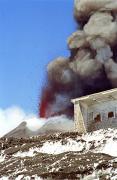This two images shows
the same aerosole ring leaving the Bocca Nuova in eastern direction. This
ring kept 15 minutes his exactly form, reached maybe the height of 4000 -
5000 m, and was carried by the strong wind in east-direction to the sea. In
the days of 2-6 april when good weather- conditions has been a rarity, the
vent of the Bocca Nuova "produced" every 10 minutes well-formed rings in the
size of 20m up to 50m. This rings can get a diameter up to 200m after a
drifting time of may 5 - 15 minutes, before they break up and disappear.


When you get the chance
to have a closer view to this rings you can see more details, and for me I
had one big question. What mechanism of currency let this rings appears like
home or pub made bocca smoke- rings?


The beginning
supposition is: a homogeneous atmosphere currency and the hot gases must
leave the vent very symmetric and fast. The involved condensing
water caused by hot/cold air meeting makes this 'aerosole ring' visible.
Then the hot driving up steam is pushing through the rough- ring, and the
colder air is slipping at the outside down. The forming process starts while
the whole thing begins to rotate....at the end very fast. The cross-section
of the rotation - form you maybe can compare with a little inside closed
tornado* because the whole thing looks like an inner tube...

May a tornado
can only build up his inner low pressure because he has a solid
resistance by the ground and can exist for longer times (the other
end is 'open'). if you would join the ground part of the tornado
with his upper (open) part, he will suck itself without resistance.
In case of the ground-free rings of Etna, the inside lower- pressure
will develop a screwing horizontal currency like a carousel. The
gravity of horizontal rotation and the itself contraction of the
lower-pressure (inside the tube) makes the ring stabile for a longer
time by supporting the 'vertical' rotation. May you can take into
consideration the inside volume (diameter of the tube), which is
steady decreasing in the cold environment, and the 'wall' parts are
getting also faster coming nearer to the tube axis.



































